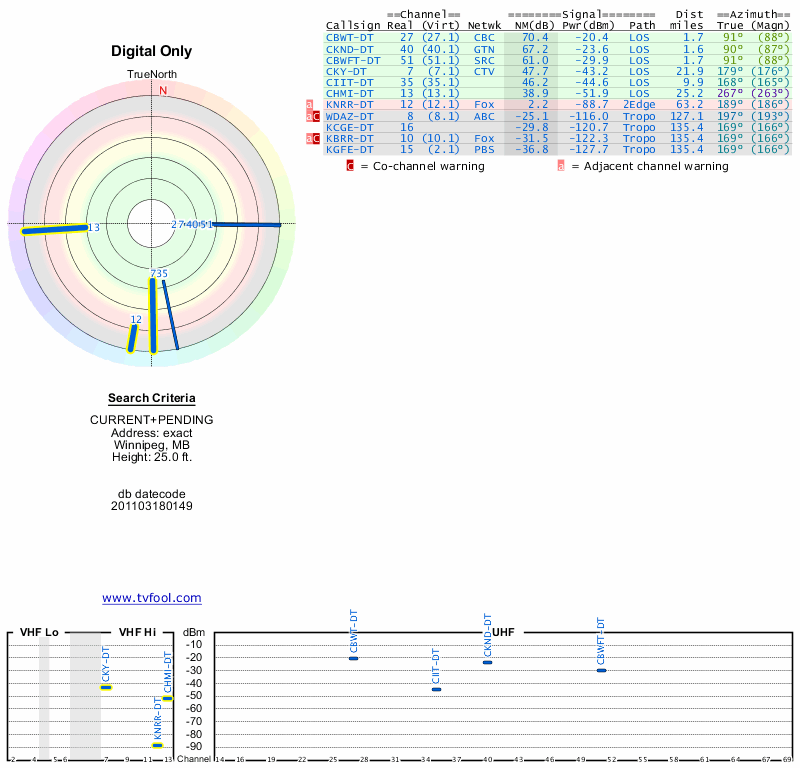OK, what do we need to know to design our over the air (OTA) TV antenna system?
What channels do we wish to receive?
There will likely be compromises. It is a good idea to spend some time thinking about what sort of compromises you would be willing to make. If you are doing this entirely for the technical challenge, then the answer to the question might be "All the channels that are humanly possible to receive from my location." If you are all or partially doing this for the TV then you will likely end up with three lists; Mission Critical (I need these to consider doing the project), Optional, and Don't care.Where are the transmitters for these channels?
This is normally a matter of public record. The appropriate government agency web site will likely have the coordinates of the local TV transmitters that you can plot on a map. You want to have some idea of where you have to aim the antenna.How strong are the signals from these transmitters?
The signal gets stronger when; the transmitter is closer, the transmitting antenna is higher, the transmitted power (measured as ERP in Watts) is greater. Signal strength is hard to predict so this is going to be a guess even with the best available information. If you have any TV antenna using neighbours you can ask them what channels they see. Online OTA enthusiast forums can be sources of reception reports for your area. In general you need larger antennas placed higher above the ground to receive weaker signals.In places with enlightened government agencies that provide TV transmitter data in a usable form people will create web sites that display this data in a way most useful to those messing around with TV antennas. As an example, my favourite site of this kind is TV Fool. After giving the site my location it gave me this:

This site does some sort of modelling and comes up with a signal strength as well as a direction and distance. This signal strength information can be quite handy even if it is not entirely accurate but for the purposes of this example I will ignore it.
What channels can we expect to receive? The people who make TV antennas often claim that their very best efforts can receive signals from as far away as 100km. This is under conditions few will ever see but it makes a nice extreme limit. The distances given on the site are in the delightfully quaint units of "miles" so I will translate into something a little more mainstream as I go along. There are 6 transmitters within 100 km on channels 7, 13, 27, 35, 40, 51. Annoyingly, KNRR on channel 12 is more or less exactly at the 100 km distance (63.2 mi). I happen to know from the reports of others and personal experience that this is a very difficult signal to receive at my location ... so we will drop it. Receiving such a marginal signal is well beyond the level of this discussion anyway. We will place all 6 channels on the Mission Critical list to keep things challenging.
There is a tendency to locate TV transmitters that serve a particular area in more or less the same place. That makes it possible for everyone in that area to point a single antenna to receive everything. Let's see how they did in my area...
So ... not so great. There are transmitters directly to the east, transmitters directly to the south, and channel 13 by itself directly to the west. This is starting to look bad. But let us now group the transmitters in terms of band to get an idea of what sort of antennas we might need. We only have two bands in use. VHF-hi (channels 7 and 13) and UHF (channels 27, 35, 40, 51). That's good. Let us now consider each band separately. On VHF-hi we have channel 13 directly west and channel 7 directly south. In other words, at right angles. That's bad. On UHF we have channel 35 pretty much at right angles to all the other channels. This is also bad but I note that the UHF transmitters other than channel 35 are only about 3km (1.7 mi) away. At that distance it is unlikely that we could do anything to prevent the reception of those channels.
We now understand the problem. We must have enough information...
Edit: channel 13 -> channel 35
Edit: removed extra period
posted at: 22:48 | path: /tv | permanent link to this entry